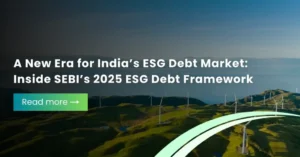Sustainable finance in India is entering a new phase, one...



In an economy moving rapidly toward net-zero, businesses can no longer afford to consider sustainability as an option. Investors, stakeholders and regulators are increasingly focusing on transparency and credibility of organizations based on how they understand, measure, mitigate, and report their emissions.
In a world where carbon emission is considered a new cost of doing business, organizations must understand exactly how much they emit, where emissions occur, and how to reduce them. This isn’t just a matter of compliance, but it’s about future-proofing the business.
In this blog, we decode what carbon accounting really entails, why it’s becoming a strategic imperative, and how companies can move from estimation to impact with the right tools and frameworks.
Carbon accounting, also known as greenhouse gas (GHG) accounting, is the process of measuring and reporting the amount of carbon dioxide (CO₂) and other greenhouse gases a company emits directly or indirectly. It provides a structured method for quantifying emissions across operations, supply chains, and product lifecycles.
Unlike financial accounting, which deals with monetary values, carbon accounting deals with emissions, which is expressed in carbon dioxide equivalents (CO₂eq). These measurements are then categorized under Scope 1, Scope 2, and Scope 3 emissions, following globally recognized standards like the GHG Protocol or ISO 14064.
The goal is not just to report solely for compliance, but to identify where emissions are coming from, understand their drivers, and make informed decisions to reduce them. Whether a company is preparing to meet regulatory requirements, set net-zero targets, or gain investor trust, carbon accounting is the first step.
In practice, carbon accounting involves the following steps:
Organizations must first define organizational boundaries (what entities to include) and operational boundaries (what emission sources to account for). This includes identifying which facilities, business units, or assets fall under direct control or ownership.
Organizations are required to categorize GHG emissions into three scopes, as per the GHG Protocol:
Once the sources are identified, organizations gather activity data, such as fuel usage, electricity bills, supplier data, or travel logs in order to quantify emissions. The quality and granularity of this data are critical for accurate accounting.
Each activity is multiplied by a relevant emission factor to calculate total GHG emissions. Emission factors are usually derived from databases managed by globally recognized institutions such as IPCC, DEFRA, EPA and reflect how much CO₂eq is released per unit of activity.
Emissions across all sources and scopes are calculated and consolidated into a GHG inventory. This can be done using spreadsheets or carbon accounting platforms, depending on the complexity and scale of the organization.
Companies prepare disclosure reports aligned with frameworks like GRI, IFRS, SASB, or BRSR. Transparency in assumptions, boundaries, methodologies, and Scope 3 estimates is crucial for credibility.
By transforming emissions data into strategic insight, effective carbon accounting helps businesses lower risks, increase productivity, and take the lead on sustainability based on facts rather than assumptions.
Today’s world, carbon accounting has evolved from a voluntary sustainability practice into a business imperative. Across sectors and geographies, companies are expected to quantify, manage, and disclose their greenhouse gas (GHG) emissions, not just to meet compliance requirements, but also to strengthen stakeholder trust, build competitive advantage, and future-proof their operations.
Global regulatory shifts are rapidly transforming climate reporting into a non-negotiable. From the EU’s Corporate Sustainability Reporting Directive (CSRD) and ESRS, to IFRS S2 disclosures in capital markets, and mandatory Scope 3 reporting in India’s BRSR Core, regulators now demand high-quality emissions data. Without robust carbon accounting, businesses risk non-compliance, penalties, and reputational damage.
Institutional investors, lenders, and global customers are increasingly using carbon performance as of the criteria for decision-making. They want to see not just targets, but credible baselines and year-on-year performance metrics, something only carbon accounting can provide.
Understanding your carbon footprint allows you to assess exposure to climate-related risks such as rising energy prices, carbon taxes, or reputational backlash. By accounting for emissions across operations and the value chain, businesses can identify hotspots, prioritize decarbonization opportunities, and allocate resources strategically.
With climate credentials becoming a differentiator in bids, investments, and partnerships, carbon accounting enables companies to move beyond broad environmental claims. It allows businesses to set realistic science-based targets, track progress, and demonstrate transparency. This not only attracts sustainability-conscious investors and customers but also supports internal goal-setting and cross-functional alignment.
Although carbon reporting is considered crucial under frameworks like GRI, IFRS S2, and the ESRS, many organizations still struggle with accurate and timely carbon accounting due to various reasons. Here are some of the key challenges businesses face:
The biggest roadblock is incomplete or inconsistent data, especially across decentralized operations and global supply chains. Many organizations still rely on manual data entry, spreadsheets, or siloed systems that make it difficult to compile accurate, real-time emission data.
Carbon accounting isn’t static. As jurisdictions update climate disclosure mandates, companies must stay aligned with changing methodologies, reporting boundaries, and definitions. Keeping pace with new requirements can be overwhelming without automated tracking systems or expert support.
Not all sustainability or finance teams are equipped with adequate technical knowledge to build a full GHG inventory. Interpreting emission factors, setting operational boundaries, and choosing between market-based or location-based accounting often demands specialized knowledge.
While there’s an explosion of ESG tools in the market, many don’t integrate well with internal systems or support global standards natively. This results in either redundant work or fragmented reports that fail to meet audit-level expectations.
Estimating emissions from third-party activities like product use, logistics, or purchased goods is still a blind spot for most businesses. Suppliers may be unwilling or unable to share data, and companies are often forced to rely on generic or outdated emission factors, leading to underreporting or estimation errors.
SAMESG ® eliminates manual tracking by automating emissions data collection across Scope 1, 2, and 3, using methodologies aligned with the GHG Protocol.
The platform stays updated with latest disclosure mandates, including BRSR Core, CSRD, and ISSB frameworks, helping businesses stay compliant without decoding complex standards.
SAMESG ® simplifies value chain emissions by offering ready-to-use templates, surveys, and dashboards that improve supplier data collection and transparency.
Every disclosure generated is traceable, version-controlled, and formatted to meet audit requirements, enabling confident stakeholder communication.
Users can set and monitor emissions reduction targets, track progress toward climate goals, and align with global standards, all within one platform.
Carbon accounting has evolved into a foundational tool for risk management, regulatory alignment, and long-term business resilience. As climate regulations tighten and stakeholder expectations rise, businesses must move from vague estimates to verifiable data.
While the process can be complex, it leads businesses towards sharper insights, stronger compliance, and a credible sustainability story. The key lies in adopting the right systems, engaging your value chain, and integrating emissions data into strategic decision-making.
For organizations ready to make this shift, ESG platforms like SAMESG ® can ease the journey, helping you simplify data collection, improve accuracy, and ensure your disclosures meet the standards, helping you steer your business to a bigger and better future. Let’s grow sustainably with transparency and accountability.
Want to know how SAMESG® works?
SAMESG® streamlines ESG reporting—automating data collection, ensuring compliance, and delivering audit-ready reports in one powerful platform.
About the author

Director – Projects & Value Chain at SAM Corporate LLC
Follow the expert:
Rajagopal Kannan is the Director of Projects & Value Chain at SAM Corporate LLC, leading ESG, risk management, and sustainability initiatives. With over 20 years of experience, including a decade in banking and financial risk, he specializes in credit structuring, Basel II & III, ISO 31000, COSO ERM, internal audit, and regulatory compliance under CBUAE, DFSA, ADGM, and SCA.
His current focus lies in ESG integration, climate and sustainability risk management, and value chain sustainability. A GRI-certified Sustainability Professional and GARP-certified SCR holder, he also holds multiple global credentials including PRM®, GRCP, GRCA, CRCMP, CBiiiPro, CSM, and CISI Level 3.
Share
Related Posts
Explore more resources